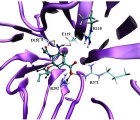We report preliminary results and a summary of a bottom-up approach to identify new, active, nontoxic, small-molecule antivirals designed to have а novel mechanism of action. We employed the procedure to identify 3-mercapto-1,2,4-triazoles derivatives as potential NP inhibitors in silico and subsequently demonstrated the in vitro efficacy of the molecules against various strains of the influenza A virus. The most efficacious compounds were successfully tested in an in vivo influenza challenge experiment.
Objectives
(1) To characterize the epidemiology of H1N1-related hospitalizations in Massachusetts; and (2) to compare characteristics of those hospitalized during periods of seasonal influenza activity and during the H1N1 pandemic.
Methods
Authors applied maximum and minimum criteria to the Massachusetts Hospital Discharge Database to identify H1N1-related hospitalizations. They constructed annual line graphs describing mean frequencies of influenza-like illness(ILI)-related discharges between 2005-2008, and compared these rates to early waves of H1N1 in 2009.
Results
During spring and summer 2009, there were significantly higher rates of ILI-related hospital discharges in Massachusetts compared to 2005-2008. Out of 359,344 total discharges between April 26-September 30,2009, H1N1-related hospitalizations ranged from 601 to 10,967 cases. Minimum criteria confirmed that H1N1 affected a younger population (50% were <18 years), with higher rates among African-Americans (18%) and Hispanics (23%) and higher rates of ICU admission (21%) compared to seasonal influenza (39%, 10%, 14%, and 17% respectively).
Conclusions
This is the first population-based assessment of epidemiological characteristics of hospitalized H1N1 cases in Massachusetts, and it is the first to include all possible hospitalized cases in the analysis. The authors confirm that large administrative data sets can detect hospitalizations for influenza during a pandemic, but estimated case counts vary widely depending on selection criteria used. Maximum criteria overestimated H1N1 activity, and those meeting minimum criteria resemble published accounts of H1N1-related hospitalizations closely.
This study investigated the relationship between school session status and H1N1 influenza prevalence. Weekly means of Influenza-like-Illness (ILI) rates over the period May 1 to October 31, 2009 were compared between areas where schools were and were not in session in the United States. Rates were substantially and significantly higher in areas where schools were in session. This result held separately in spring and fall and was robust to various controls.
Infection of pigs with influenza viruses is a cause of considerable economic loss for pig farmers as well as a potential human health concern – as evidenced by the identification of genetic material derived from swine-adapted influenza viruses in an novel strain of H1N1 influenza virus in 2009. A study was conducted investigating the prevalence of influenza virus infection in a selection of 143 English pig herds between April 2008 and April 2009, which found evidence of recent virus circulation in over half of these herds (n=75). Farms which were sampled in the Summer months were found to have lower odds of recent virus circulation, as were farms containing pigs kept in straw yards. Additionally, farms containing pigs kept indoors and farms containing high numbers of finisher pigs per water space were found to have higher odds of recent virus circulation. It is hoped that further studies will expand on these findings, and may allow targeting of surveillance for influenza viruses in the English pig population.
A list of 27 promising antiviral drugs is proposed for use against the H1N1pdm strain. Since the binding site of the H1N1pdm neuraminidase is similar to that of the bird flu H5N1, an effective means to quickly identify top candidates for use against H1N1pdm is to use known bird-flu drugs and the 27 compounds from the NCI diversity set which bind best to H5N1 neuraminidase. These compounds serve as viable candidates for docking against the H1N1pdm neuraminidase, using ensembles extracted from molecular dynamics simulations of the H1N1pdm system. The ranking order of these top candidates was found to be different from the previously published results for H5N1. The results indicated that the Oseltamivir (Tamiflu) and Peramivir drugs have higher ranking than Zanamivir (Relenza). However, six drug candidates were found to bind more effectively to H1N1pdm neuraminidase than Tamiflu. Detailed hydrogen bond network analysis for these six candidates is also provided.
Influenza C contributes to economic damage caused by working days lost through absence or inefficiency and may occasionally cause an acute respiratory illness in a paediatric setting. All Influenza C sequences from the NCBI Influenza Virus Resource were examined to determine the date of the most recent common ancestor (t-MRCA), the average nucleotide substitution rate, and the location of residues under positive selection, for each of the seven genome segments of this virus. The segment with the deepest phylogeny was found to be segment 4, encoding the haemagglutinin-esterase protein (HE) with mean t-MRCA at 1890 of the common era (AD), at a 95% highest posterior density (HPD) of 1857-1924 AD. Other genome segments have slightly more recent common ancestors, ranging from mean t-MRCAs of 1916 AD (HPD 1891-1937) for segment 7, encoding the two non-structural proteins (NS) to 1944 AD (HPD 1940-1948) for segment 2 encoding the type 1 basic polymerase (PB1). On the basis of the Bayesian analysis a reclassification of lineages within genome segments is proposed. Some evidence for positive selection was found in the receptor-binding domain of the haemagglutinin-esterase protein. However, average ω (omega) values ranged from 0.05 for polymerase basic protein 2 (PB2) to 0.38 for non-structural protein 2 (NS2), suggesting that strong to moderate purifying selection is the main trend. Characteristic combinations of segment lineages were identified (genome constellations) and shown to have a relatively short life-span before being broken up by reassortment.
Severity of seasonal influenza A epidemics is related to the antigenic novelty of the predominant viral strains circulating each year. Support for a strong correlation between epidemic severity and antigenic drift comes from infectious challenge experiments on vaccinated animals and human volunteers, field studies of vaccine efficacy, prospective studies of subjects with laboratory-confirmed prior infections, and analysis of the connection between drift and severity from surveillance data. We show that, given data on the antigenic and sequence novelty of the hemagglutinin protein of clinical isolates of H3N2 virus from a season along with the corresponding data from prior seasons, we can accurately predict the influenza severity for that season. This model therefore provides a framework for making projections of the severity of the upcoming season using assumptions based on viral isolates collected in the current season. Our results based on two independent data sets from the US and Hong Kong suggest that seasonal severity is largely determined by the novelty of the hemagglutinin protein although other factors, including mutations in other influenza genes, co-circulating pathogens and weather conditions, might also play a role. These results should be helpful for the control of seasonal influenza and have implications for improvement of influenza surveillance.
Between 18 May 2009 and 3 May 2010, a total of 149 fatal cases associated with pandemic influenza A (H1N1) were reported in Greece. Detailed case-based epidemiological information was available for the large majority of fatal cases. The time distribution follows an epidemic curve with a peak in the beginning of December 2009 and a second peak one month later. This is similar to that of laboratory confirmed cases and influenza-like illness cases from our sentinel surveillance system, with two weeks delay. The most commonly reported underlying conditions were chronic cardiovascular disease and immunosuppression, while the most frequently identified risk factor was obesity. These findings should be taken into consideration, when vaccination strategies are employed.
Introduction: Previous studies investigating determinants of 2009 (H1N1) pandemic influenza vaccine acceptance have focused on target groups such as healthcare workers. Few studies in the European Union have examined the self-reported reasons as well as predictive socio-demographic and health factors for pandemic influenza vaccine acceptance in the general population, even though influenza vaccine was recommended for all people.
Methods: A nationwide telephone survey was conducted in France during the peak of the outbreak that occurred in December 2009 in adults (≥ 16 years), using a proportional random-digit dialing.
Results: Interviews were completed by 1003 individuals, of whom 275 (27.4%) either had received pandemic influenza vaccine during the last weeks or intended to get vaccinated in the next weeks. Acceptance rates of pandemic vaccine were significantly higher among men, more educated and wealthier people, as well as persons who had a prior experience of influenza vaccination. The patterns of self-reported reasons for vaccine acceptance could be broadly divided into 3 groups related to (1) the mental representation of the threat – in particular the beliefs associated with the severity and personal vulnerability to the illness, (2) the perception of efficacy and safety of the vaccine, and (3) trust/distrust toward those advocating the vaccine.
Conclusions: This national study indicates that social and cognitive determinants of pandemic influenza vaccine acceptance among French adults were relatively similar to those identified by previous studies of acceptance of seasonal influenza vaccine.
A simulation model called VirSim was developed to aid policy making in Sweden. The model simulates the spread of pandemic influenza, using real population data on a national and regional level. Swedish authorities wanted a model that was both quick to run and to implement as a complement to the existing model MicroSim. The possibility to interactively investigate the effect of varying different assumptions was an important aspect. The VirSim model proved useful for comparing different interventions strategies, and for forecasting the societal burden in terms of hospitalization and workplace absenteeism. This paper points out the usefulness of System Dynamics models in public policy making, as a complement to more detailed and time-consuming models.




